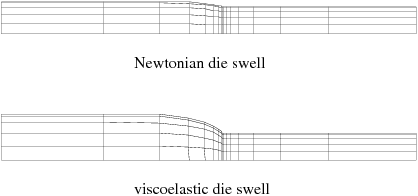By default, Ansys Polyflow evaluates the direction at a given node
as the normal to the initial mesh.
does not change, except for evolution and time-dependent problems,
as discussed below. You can, however, specify the direction yourself, either along
the boundary of the moving surface or along the entire moving surface. The direction
that you specify will apply to all affected nodes; you cannot specify a different
direction for each node.
Specifying along the boundary of the moving surface is useful if a plane (or
line) of symmetry is located on one side of the moving surface. Specifying
along the entire moving surface is useful if large deformations
are expected, in order to prevent directors from crossing. If you specify
along the entire moving surface, use the direction that is mostly
orthogonal to the surface.
Note that the directors have no effect on the displacement of the moving surface when the line kinematic condition is used.
The boundary of the free surface or moving interface is identified as a sequence of intersections with adjacent boundary sets and (for moving interfaces) adjacent subdomains. In Figure 15.9: Boundary of a Free Surface, for example, the boundary of the free surface represented by boundary set 5 is composed of the intersections between BS5 and BS2, BS5 and BS4, BS5 and BS6, and BS5 and BS9, where the intersection is represented by a *.
Along the intersection between a plane (or line) of symmetry and a free
surface or moving interface, it is recommended that the director be contained in the plane of symmetry. For steady-state
problems where the normal to the initial mesh is contained in the plane of
symmetry, this is not required (although it is correct), since the director will
never be computed on the deformed mesh.
It is absolutely required for evolution and time-dependent problems, and also if you restart a problem from a deformed initial mesh. If you do not define the director in the plane of symmetry, nodes can move out of the plane of symmetry when remeshing occurs.
Although directors are not recalculated during iterations, they are recalculated before each evolution or time step by default. You can override this by specifying that directors should be evaluated only once at the beginning of the task (See General Procedure).
Calculating directors at each step is recommended for problems involving large deformations, such as viscoelastic flow problems where large swelling effects are expected. The normal to the free surface near the die lip is almost vertical for a Newtonian fluid, and almost horizontal for a viscoelastic fluid (Figure 15.10: Newtonian and Viscoelastic Die Swells). The director calculation at each step is highly recommended for high-Weissenberg-number flows.




